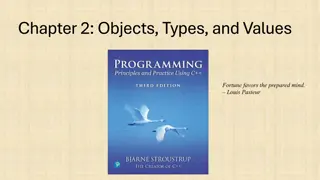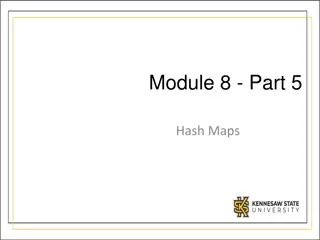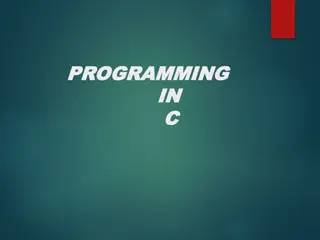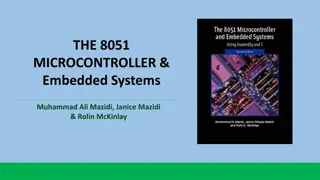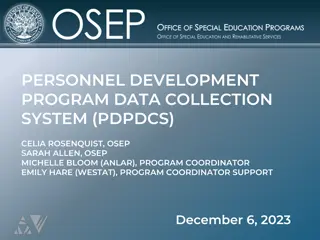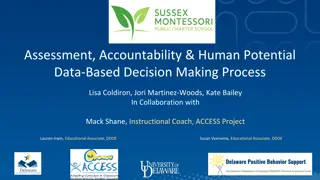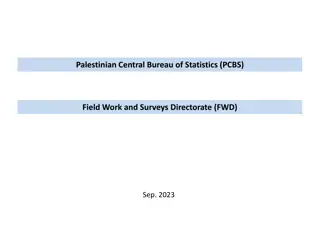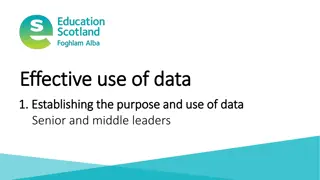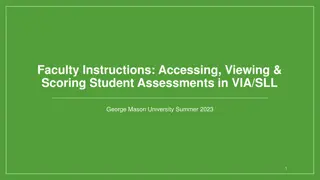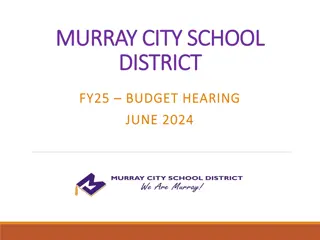Unlocking Assessment: The Value of Data Collection in Programming
Discover the significance of assessment in program development, understand its role in planning, and explore various assessment methods. Lei Dunn shares insights on leveraging assessment for academic excellence and program success.
Download Presentation
Please find below an Image/Link to download the presentation.
The content on the website is provided AS IS for your information and personal use only. It may not be sold, licensed, or shared on other websites without obtaining consent from the author. Download presentation by click this link. If you encounter any issues during the download, it is possible that the publisher has removed the file from their server.
Presentation Transcript
Please answer these 3 questions on a piece of paper; no discussion with your neighbor True or False: An assessment includes a test, measurement and evaluation. Which word means the process of collecting data on the property or attribute of interest? Test Measurement Evaluation Which stages of program development might you use assessment? 1
The Value of Assessment Lei Dunn, M.Ed., CHES July 10, 2023
Muraho! I am Lei Dunn I am the K-12 Instructional Specialist in Health and Physical Education for Virginia Beach City Public Schools, adjunct faculty with the Darden School of Education at Old Dominion University and a doctoral student in Education Leadership at Liberty University You can find me on Twitter at @leidunn_vb 3
We have 3 objectives today Understand the cycle of assessment The Value of The Value of Assessment Assessment Describe assessment fits in program planning Discuss different methods of assessment 4
What does the word TEST mean to you? Let us list some descriptive words. 5
BIG IDEA BIG IDEA An assessment (isuzumabumenyi) is made up of three parts - test, measure and evaluate. 6
ASSESSMENT is Isuzumabumenyi ASSESSMENT is Isuzumabumenyi and then making an evaluation based on these results. The process of gathering information, analyzing the data or information, 7
ASSESSMENT is Isuzumabumenyi ASSESSMENT is Isuzumabumenyi TEST ibazwa MEASURE EVALUATE 8
Definitions TEST TEST Ibazwa Ibazwa A type of instrument or procedure that measures the attributes or properties of an individual. MEASURE MEASURE Process of collecting data on the property or attribute of interest. EVALUATE EVALUATE Process of interpreting the collected measurement and determining some worth or value. 9
A TEST (ibazwa) IS A TOOL A TEST (ibazwa) IS A TOOL 10
Two Types of Measurement Two Types of Measurement QUANTITATIVE QUANTITATIVE Time to run a 5k Grade on a classwork assignment Score on an Ordinary Exam QUALITATIVE QUALITATIVE Level of friendship Hygiene checklist Speech 11
Evaluation should be shared with the student. 12
BIG IDEA BIG IDEA Within the assessment cycle, there are different types of tests to help us understand what our students know and still need to learn. 13
Within the Assessment Cycle, there is more detail to help us understand what our students know and still need to learn. Pre Pre- -Assess Assess EVALUATE EVALUATE Summative Summative TEST TEST MEASURE MEASURE Formative Formative 14
Formative assessments, sometimes called checks for understanding or exit tickets, should be used throughout class time with little preparation time for the student. Formative assessments, sometimes called checks for understanding or exit tickets, should be used throughout class time with little preparation time for the student. 15
SUMMATIVE ASSESSMENTS SUMMATIVE ASSESSMENTS Students should be notified about them ahead of time. Do not have to be long, but should cover all concepts taught during the lessons. Should be schedule based on completion of a particular unit, not certain school dates. 16
BIG IDEA BIG IDEA Assessment is an important part of program planning. 17
Program planning is how you decide what you are going to teach, why you are teaching it and how you will teach it. Program planning is how you decide what you are going to teach, why you are teaching it and how you will teach it. 18
Program planning is made up of 5 stages Program planning is made up of 5 stages 1. Establishing a program philosophy 2. Developing goals 3. Planning activities* 4. Delivering lessons* 5. Evaluating and improving* *Assessment in education is used during these last 3 stages. 19
Program planning is made up of 5 stages Program planning is made up of 5 stages 1. Establishing a program philosophy 2. Developing goals 3. Planning activities* 4. Delivering lessons* 5. Evaluating and improving* When planning activities you can use pre- assessments to decide if the activities will be appropriate for your students. 20
Program planning is made up of 5 stages Program planning is made up of 5 stages 1. Establishing a program philosophy 2. Developing goals 3. Planning activities* 4. Delivering lessons* 5. Evaluating and improving* When you are delivering lessons, checking for understanding (also called formative assessment) can tell you if your students are learning the material or if you need to try a different activity. 21
Program planning is made up of 5 stages Program planning is made up of 5 stages 1. Establishing a program philosophy 2. Developing goals 3. Planning activities* 4. Delivering lessons* 5. Evaluating and improving* When evaluating your program, summative (final) assessments tell you if your students learned what you intended for them to learn or if you or they need to make some changes. 22
Lets talk about the elephant in the room. Fitness testing can be an appropriate tool for assessment when used properly.
Consider the ethics of measuring a child s fitness test scores. 24
Consider your motives What are your personal biases regarding fitness testing, positive or negative? 25
Description and Function VA SMART Goals should follow Wellness Tests 26
BIG CONCEPT BIG CONCEPT SMART goals and fitness testing work together in reality and in grading. 27
Virginia Health AND PE SOLs Relating to SMART Goals and FItness Testing Fitness Testing Fitness Testing 4.3.b, 5.3.a, 5.3.b, 6.3.e, 6.3.a, 7.3.b, 8.3.a, 11/12.3a SMART Goals SMART Goals 4.3.e, 5.3.b, 6.3.a, 7.3.b, 8.3.a, 9.3.f, 10.3.a, 11/12.3.e FITT Principle FITT Principle 4.3.f, 5.3.c, 6.3.f, 6.3.a, 7.3.c, 7.3.b, 8.3.c, 8.3.d, 9.3.a, 11/12.3.b, 11/12.3.c, 11/12.3.e 6.3.f, 8.1.f, 8.3.g* 4.3.e, 8.3.h, 9.3.d; 10.3.b, 10.3.c* *Health SOL s 28
These two cycles work in harmony throughout a health and PE course Fitness Fitness Test Test Evaluat Evaluat e e Test Test FITT FITT Plan Plan SMART SMART Goal Goal Measure Measure 29
BIG CONCEPT BIG CONCEPT Printed journals give students regular reminders of where they started and where they are going. 30
Benefits of Offline Journals Fast Simple to navigate Easy summative or formative assessment You do lose the ability to apply accomodations with paper and pencil, plus if it gets lost, the student would need to start over. 31
Most appropriate when Most appropriate when 3rd grade through 8th grade The teacher is keeping the journal between classes Students are completing the workouts during HPE class time Students have HPE class 3 or more times per week 32
Link to Paper Journal Link to Paper Journal https://docs.google.com/document/d/1-5dTyogIXKRdbNxUlBBmsf12-naJLq6u/copy 33
Plan to make fitness a habit for your students. 34
Digital Goal Tracking & Portability Accountability 35
BIG CONCEPT BIG CONCEPT Digital journals offer a real-world fitness experience. 36
Most appropriate when Most appropriate when 6th grade through 12th grade The teacher is only checking journal periodically Students are completing the workouts during HPE class or at home Students have HPE class 1-3 times per week 37
Benefits of Digital Tracking Accessible from a variety of settings Adaptability Most useful for summative assessment You do lose the ability to tack your tracking to a variety of settings, outside for instance; this format also requires every student to have access to a device, sometimes out of school as well. 38
Place your screenshot here Link to Online Journal Link to Online Journal https://docs.google.com/forms/d/1X5ZmqiQQYoebWdeDiFlj6974zugQt6yZjsifv8WBXq 0/copy 39
Remember to give students agency of their scores and plans. 40
Other Digital Tracking Formats If you have access to Welnet, you have access to digital tracking and assessment tools that will move with your student through each grade level. Other Digital Tracking Formats 41
To grade or not to grade To grade or not to grade Yes Yes Ability to correctly perform the skills needed to test.^ Ability to correctly record scores including correct unit of measure Ability to identify needed improvements including component of fitness No No Scoring in the healthy fitness zone Maybe Maybe Improved score* ^ Must be adjusted for students with physical disabilities. * Dependent on ability to track physical activity. 42
Remember to Consider all students needs when creating assessments 43
Now let us try this again: True or False: An assessment includes a test, measurement and evaluation. Which word means the process of collecting data on the property or attribute of interest? Test Measurement Evaluation Which stages of program development might you use assessment? 44
Check your answers. True or False: An assessment includes a test, measurement and evaluation. Which word means the process of collecting data on the property or attribute of interest? Test Measurement Evaluation Which stages of program development might you use assessment? 3, 4 and 5 45
Thanks! Any questions? Any questions? You can find me at @leidunn_vb & lcdunn@vbschools.com 46
Sources Chappuis, S., & Stiggins, R. (2002, September 1). Classroom assessment for learning. ASCD. https://www.ascd.org/el/articles/classroom-assessment-for-learning Lacy, A.C. & Williams S.M. (2018). Measurement and evaluation in physical education and exercise science (8th Ed.). Routledge. ISBN 9781138232341 47









